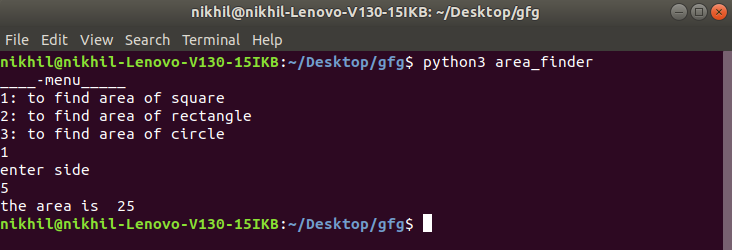Usage of __main__.py in Python
Last Updated :
01 Dec, 2022
Many of us have worked with creating their own custom module in Python and is well familiar with the candidate ‘__init__.py’. If you do not know then let’s get a brief and short description of ‘__init__.py’ before diving deep into the concerned topic. Actually, when we try to import a module to Python by default the __init__.py is accessed by Python to look for the necessary imports. Now there are two scenarios.
- Python files which are well organized to be imported as modules
- Python files (single file structure) which can be run directly by command line
In the first scenario when we try to import it as a module __init__.py comes into play. For the second scenario we use some hackish syntax like
Python3
def main ():
pass
if __name__ == '__main__':
main()
|
This syntax can be related to starting of main in other languages like JAVA and C++. But this syntax will not work ideally with the third scenario. Then what to do if we want to run such files directly from command line ? This is where __main__.py comes to rescue. Let’s take an example, we will find the area of a rectangle, square, and circle. For the sake of understanding, let’s divide the three operations under three separate .py files and store it in a module named src. The file tree will look like this
+---src
| | circle.py
| | rectangle.py
| | square.py
| | __init__.py
| |
Now src can be imported as a module from any other Python program if added to path. But what if we want to run it from command line. For this we store the src folder under a folder named say area_finder and add a file named __main__.py under it . The tree would look like
area_finder
| readme.md
| __main__.py
|
+---src
| | circle.py
| | rectangle.py
| | square.py
| | __init__.py
| |
content of __main__.py
Python3
print("____-menu_____")
print("1: to find area of square \n\
2: to find area of rectangle\n\
3: to find area of circle")
ch = int(input())
if ch == 1:
from src.square import square
print("enter side")
s = int(input())
print ("the area is ", square(s))
if ch == 2:
from src.rectangle import rectangle
print("enter length and breadth")
l = int(input())
b = int(input())
print("the area is ", rectangle(l, b))
if ch == 3:
from src.circle import circle
print("enter radius")
r = int(input())
print("the area is ", circle(r))
|
Now when we run them from terminal/command prompt like this
python area_finder
The output will be –  So what happens when we execute the command. Python looks for a file named __main__.py to start its execution automatically. If it doesn’t find it will throw an error else it will execute main.py and from the code, you can well understand that it will import the modules from src to find the area. So now we have learned how __main__.py works. Now, let’s take a look at its biggest advantages:
So what happens when we execute the command. Python looks for a file named __main__.py to start its execution automatically. If it doesn’t find it will throw an error else it will execute main.py and from the code, you can well understand that it will import the modules from src to find the area. So now we have learned how __main__.py works. Now, let’s take a look at its biggest advantages:
- It removes the ambiguity among end-user about the entry point of the program as Python does it automatically
- It helps in clean execution of the code
Like Article
Suggest improvement
Share your thoughts in the comments
Please Login to comment...